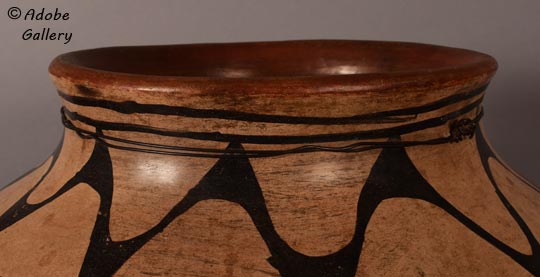Kiua Polychrome Cochiti Variety Magnificent c.1820 Storage Jar [SOLD]
+ Add to my watchlist Forward to Friend
- Category: Historic
- Origin: Cochiti Pueblo, KO-TYIT
- Medium: clay, pigment
- Size: 23” height x 22” diameter
- Item # C4815B SOLD
Symmetry and Symbolism: The Artistry of a 19th Century Cochiti Pueblo Pottery Jar
The Cochiti Pueblo historic pottery storage jar has a beautiful symmetrical globular body. There is a slight tilt when viewed from one position but when the jar is rotated properly, the tilt is not visible. The jar sits firmly when rotated in any position.
The design concept is simple—a series of six floral medallions encircle the mid body of the jar as the sole designs on the body. There are three pairs of framing lines—one pair at the rim, one pair at the lower neckline, and a pair at the bottom of the cream slip dividing it from the wide red wiped-on band. All six of the framing lines feature ceremonial line breaks. The potter got creative with the framing lines by adding rain clouds suspended from them. Some of the clouds are solid black with a vertical line opening, and others are more ferocious billowing rain clouds. A band of rainclouds rests on the lower framing line.
The jar dates to circa 1820. It is identified as Kiua Polychrome - Cochiti Variety. Cochiti and Santo Domingo Pueblos are neighboring villages of what is termed the Keresan Pueblos, based on their Keres language.
The history of northeast Keres ceramics is clouded through the period of 1700 to 1850. Very few sherds were available for study and those available came only from Cochiti Pueblo. It is believed that very little pottery was made at those pueblos from 1700 to 1800, therefore there has been little to study. Pottery from the early 1800s has been classified as Kiua Polychrome Cochiti Variety and Kiua Polychrome Santo Domingo Variety. [Harlow 1973:44]
"Starting about 1820, a guess that may be off either way by 20 years, the ceramics of Cochiti and Santo Domingo began to diverge significantly. The collections by Stevenson in 1880 show considerable difference between the two villages. Santo Domingo Pueblo had found the early formal geometric style to its liking and in a demonstration of extreme conservatism, perpetuated the style with so little change that vessels made of a period of nearly a century are almost undateable." ibid, 47
Condition: very good condition. Black light reveals one vertical crack from midbody to lower section that has been professionally conserved and overpainted.
Provenance: this Kiua Polychrome Cochiti Variety Magnificent c.1820 Storage Jar is from the collection of a client of the gallery
Reference: Harlow, Francis H. Matte-Paint Pottery of the Tewa, Keres and Zuni Pueblos, University of New Mexico Press, 1973
TAGS: Southwest Indian Pottery, Cochiti Pueblo, Historic Pottery

- Category: Historic
- Origin: Cochiti Pueblo, KO-TYIT
- Medium: clay, pigment
- Size: 23” height x 22” diameter
- Item # C4815B SOLD
Adobe Gallery Recommended Reading
Adobe Gallery Recommended Items
If you are interested in this item, we would also like to recommend these other related items:



